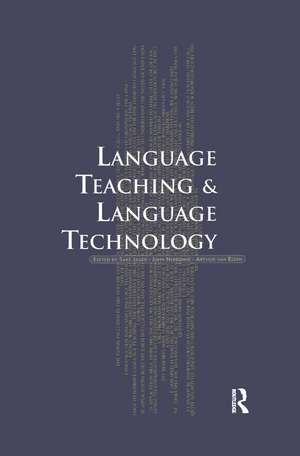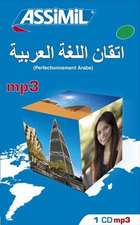Language Teaching and Language Technology
Editat de Arthur van Essen, Sake Jager, John Nerbonneen Limba Engleză Paperback – 4 aug 2016
| Toate formatele și edițiile | Preț | Express |
|---|---|---|
| Paperback (1) | 312.43 lei 6-8 săpt. | |
| Taylor & Francis – 4 aug 2016 | 312.43 lei 6-8 săpt. | |
| Hardback (1) | 767.01 lei 6-8 săpt. | |
| Taylor & Francis – 1998 | 767.01 lei 6-8 săpt. |
Preț: 312.43 lei
Preț vechi: 356.63 lei
-12% Nou
Puncte Express: 469
Preț estimativ în valută:
59.79€ • 62.07$ • 49.86£
59.79€ • 62.07$ • 49.86£
Carte tipărită la comandă
Livrare economică 22 martie-05 aprilie
Preluare comenzi: 021 569.72.76
Specificații
ISBN-13: 9781138993051
ISBN-10: 1138993050
Pagini: 242
Dimensiuni: 152 x 229 mm
Greutate: 0.45 kg
Ediția:1
Editura: Taylor & Francis
Colecția Routledge
Locul publicării:Oxford, United Kingdom
ISBN-10: 1138993050
Pagini: 242
Dimensiuni: 152 x 229 mm
Greutate: 0.45 kg
Ediția:1
Editura: Taylor & Francis
Colecția Routledge
Locul publicării:Oxford, United Kingdom
Notă biografică
Essen, Arthur van; Jager, Sake; Nerbonne, John
Cuprins
Chapter 1 Language Teaching and Language Technology, John Nerbonne, Sake Jager, Arthur van Essen; Part 1 Speaking; Chapter 2 Computational Autosegmental Phonology in Pronunciation Teaching, Julie Carson-Berndsen; Chapter 3 Application of New Technologies in the Development of Educational Programs, Pavel Skrelin, Nina Volskaya; Chapter 4 Computer-Assisted Pronunciation Teaching Based on Automatic Speech Recognition, Silke Witt, Steve Young; Part 2 Vocabulary; Chapter 5 Integrating CALL into the Vocabulary Classroom, Bernadine McCreesh; Chapter 6 Second Language Acquisition from Aligned Corpora, Elena Paskaleva, Stoyan Mihov; Chapter 7 New Capabilities For Russian and Ukrainian Language Learning Based on the Language Processor Russicon, Serge A. Yablonsky; Part 3 Grammar; Chapter 8 RECALL – Providing an Individualized CALL Environment, Maureen Murphy, Anja Krüger, Andrea Grieszl; Chapter 9 COOL/CALP: Computer-Assisted Learning to Parse in Dutch, Vincent J. van Heuven; Chapter 10 Hologram Computer-Assisted Academic Grammar Learning, Sake Jager; Part 4 Reading, Writing and Testing; Chapter 11 A Session with Glosser-RuG, Duco Dokter, John Nerbonne; Chapter 12 Native English™ Writing Assistant – A CALL Product for English Reading and Writing, Qian Hu, Jeff Hopkins, Marianne Phinney; Chapter 13 GLOSSER—Using Language Technology Tools for Reading Texts in a Foreign Language, Tiit Roosmaa, Gabor Prószéky; Chapter 14 CAT: Computer-Aided Testing in the Teaching of Dutch as a Second Language (DSL) The Importance of Validity, Sjoerd de Vos, Hilde Hacquebord; Part 5 Distance Learning; Chapter 15 WELLS: Web-Enhanced Language Learning, Alessandro Allodi, Duco Dokter, Edwin Kuipers; Chapter 16 The Grammar of Second Language Learners of English EMAIL Messages, Lloyd Holliday; Chapter 17 The New Face of Distance Learning in Language Instruction, Martin Rothenberg; Part 6 Users: Models and Studies; Chapter 18 An Implemented Interlanguage Model for Learners of Basque, Arantza Díaz de Ilarraza, Montse Maritxalar, Maite Oronoz; Chapter 19 Glosser-RuG: A User Study, Duco Dokter, John Nerbonne, Lily Schürcks-Grozeva, Petra Smit; Chapter 20 Knowledge Structures and Their Application in CALL Systems, Ivo Düntsch, Günther Gediga; Chapter 21 ‘Learning Itineraries’: Getting Students to Use CALL Software optimally, Francesca Giardini, Carla Vergaro; Chapter 22 RECALL—Some Implications of Learner as User in CALL, Simon Hamilton; Part 7 Reflections and Visions; Chapter 23 Large-Scale Implementation of Spanish CALL at Brigham Young University, Harold H. Hendrick; Chapter 24 For, Against, For the Development and Dissemination of CALL, Frank L. Borchardt;

